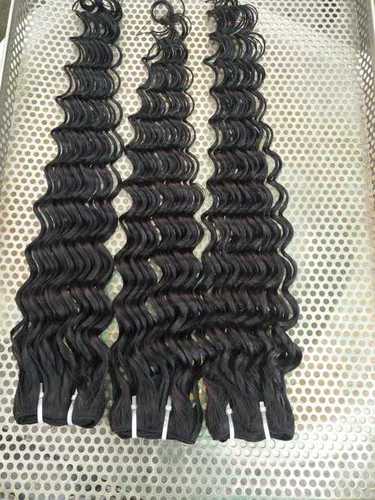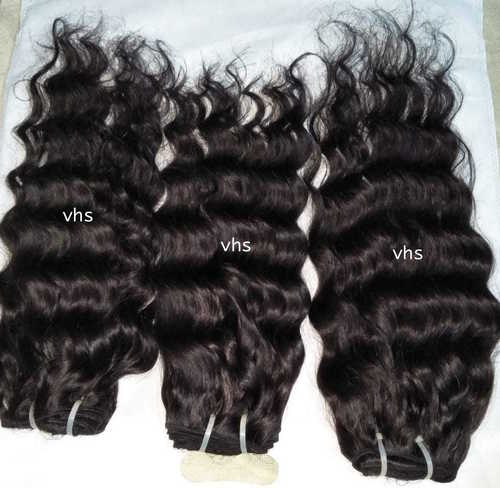India's Human Hair Factory
Call Us
Free Support :

Indian Human Hair
50 INR/Piece
Product Details:
- Product Type Human Hair
- Material Human Hair
- Hair Grade Remy Hair
- Human Hair Type Indian
- Style Curly
- Length 10 To 30 Inch (in)
- Weight (kg) 100 Gram (g)
- Click to view more
X
Indian Human Hair Price and Quantity
- 40.00 - 90.00 INR/Piece
- 1 Piece
- 50 INR/Piece
Indian Human Hair Specification
- Human Hair
- Human Hair
- Indian
- Curly
- 100 Gram (g)
- 10 To 30 Inch (in)
- black, blonde ,brown
- Remy Hair
Indian Human Hair Trade Information
- ship from our head office Kanpur
- Paypal, Telegraphic Transfer (T/T), Cash in Advance (CID), Cash Advance (CA)
- 10000 Piece Per Month
- 5 -7 Months
- Sample costs shipping and taxes has to be paid by the buyer
- We use transparent Polybag for Packaging or Any customization can be done according to client need.
- All India
Product Description
Indian human hair is highly regarded in the global hair extension and wig industry for its quality and texture. It is a popular choice for people looking to enhance their natural hair or create wigs and extensions.
Here are some key points about Indian human hair:
1. Texture and Quality: Indian human hair is known for its natural, lustrous, and silky texture. It is typically straight or has a slight wave, making it versatile and suitable for various styling options.
2. Ethical Sourcing: Ethical practices are essential in the hair trade, and reputable Indian hair suppliers ensure that the hair is sourced ethically and that the donors are compensated fairly for their hair.
3. Versatility: Indian human hair can be easily dyed, curled, and straightened to achieve different looks. Its natural texture and color make it adaptable for various styles and preferences.
4. Long Lengths: Indian hair is often available in longer lengths, which is ideal for individuals who want to add length and volume to their natural hair.
5. Durability: High-quality Indian human hair can last for a long time with proper care. Regular maintenance, such as washing, conditioning, and styling, can help prolong its lifespan.
6. Cost: The cost of Indian human hair can vary depending on factors like length, quality, and source. Some of the finest quality Indian hair can be relatively expensive.
7. Sources: Indian human hair is primarily sourced from donors in India, where the tradition of donating hair at temples is common. These temples collect the hair, which is then sold and used to make wigs and extensions.
8. Varieties: Indian human hair comes in different types, including virgin hair (unprocessed and untreated) and Remy hair (cuticles aligned in the same direction). Remy hair is often considered higher quality due to its cuticle alignment, which prevents tangling and matting.
9. Usage: Indian human hair is used in a wide range of products, such as wigs, weaves, extensions, and hairpieces. It is a preferred choice for many people looking to achieve a natural look and feel.
Advantages of Indian Human Hair:
1. Natural Appearance: Indian human hair has a natural appearance and texture that closely resembles the characteristics of many peoples natural hair, making it blend seamlessly for a realistic look.
2. Versatility: Indian hair is highly versatile and can be easily styled, dyed, curled, or straightened to achieve various looks. Its adaptability allows for creative styling options.
3. Long Lengths: Indian human hair is often available in long lengths, which is ideal for individuals who desire added length and volume. Longer hair can be cut and styled to meet specific preferences.
4. Durability: With proper care and maintenance, high-quality Indian human hair can last for a long time. Its durability makes it a cost-effective option for those looking for long-term solutions.
5. Ethical Sourcing: Many reputable suppliers of Indian human hair prioritize ethical sourcing practices. The hair is often obtained from donors in India who willingly offer their hair for religious or cultural reasons, and they are compensated fairly for their contributions.
6. Diversity of Textures: While Indian hair is typically straight or slightly wavy, there is some variety in texture depending on the region of origin. This diversity allows individuals to choose a texture that matches their own natural hair or desired style.
7. Minimal Shedding and Tangling: High-quality Indian human hair, especially Remy hair, is less prone to shedding and tangling because the cuticles are aligned in the same direction. This minimizes friction and helps maintain the hairs integrity.
8. Natural Color Range: Indian human hair is available in a wide range of natural colors, from black to various shades of brown. This natural color spectrum makes it easier to find a match for your own hair color or style.
9. Adaptability for Customization: Indian human hair can be customized to meet individual preferences. It can be tailored to various lengths, colors, and styles to suit the specific needs of the wearer.
10. Comfort and Breathability: Wigs and extensions made from Indian human hair are often more comfortable to wear than synthetic alternatives. They allow for better airflow and reduce discomfort associated with synthetic materials.
11. High-Quality Options: There are various grades and qualities of Indian human hair available, allowing customers to choose according to their budget and requirements.
Frequently Asked Questions:
Q. What is Indian human hair?
Ans: Indian human hair is natural hair collected from donors in India, known for its high quality, texture, and versatility. It is used to create wigs, weaves, extensions, and other hair products.
Q. How is Indian human hair sourced?
Ans: Indian human hair is often sourced from donors who willingly offer their hair for religious or cultural reasons, such as hair tonsuring ceremonies at temples. Ethical suppliers ensure that donors are compensated fairly.
Q. What is the difference between Indian human hair and other types of human hair?
Ans: The main differences lie in the texture and characteristics. Indian hair is known for its straight or slightly wavy texture, while other types like Brazilian or Malaysian hair have different natural textures.
Q. Can Indian human hair be dyed or styled?
Ans: Yes, Indian human hair can be dyed, curled, straightened, and styled just like natural hair. It is highly versatile and can adapt to various styling options.
Q. What is Remy hair?
Ans: Remy hair is a high-quality type of Indian human hair where the cuticles are aligned in the same direction, reducing tangling and matting. It is often considered superior due to its exceptional quality.
Q. How long does Indian human hair last?
Ans: The lifespan of Indian human hair depends on its quality and how well it is maintained. With proper care, high-quality Indian human hair can last for several months to even a couple of years.
Q. How should I care for Indian human hair?
Ans: Proper care includes regular washing, conditioning, detangling, and avoiding excessive heat styling. Its essential to follow care instructions provided by the supplier.
Q. What is the cost of Indian human hair?
Ans: The cost varies based on factors such as quality, length, and source. Higher quality Indian human hair is typically more expensive. Prices can range from relatively affordable to quite expensive.
Q. Where can I buy Indian human hair products?
Ans: Indian human hair products are available from various suppliers, both online and in physical stores. Its crucial to do your research and purchase from reputable and ethical suppliers.
Q. Are Indian human hair products comfortable to wear?
Ans: Yes, Indian human hair products are often more comfortable to wear than synthetic alternatives. They provide better breathability and a more natural feel.
Q. Do Indian human hair products come in different textures and colors?
Ans: While Indian human hair is typically straight or slightly wavy, there is some variation in texture based on the region of origin. The natural color range includes black and various shades of brown. Customization options are available.
Q. Are there any ethical concerns regarding Indian human hair?
Ans: Ethical concerns may arise if the hair is not sourced ethically or if donors are not compensated fairly. To address this, its important to choose suppliers who prioritize ethical practices.
Tell us about your requirement

Price:
Quantity
Select Unit
- 50
- 100
- 200
- 250
- 500
- 1000+
Additional detail
Mobile number
Email
Other Products in 'Hair Extensions' category
Our Major export market is United states of America, United Kingdom, France, Spain, Italy, Dubai, Ethiopia, Kenya, Mexico, Brazil and rest of the World.
 English
English Spanish
Spanish French
French German
German Italian
Italian Chinese (Simplified)
Chinese (Simplified) Japanese
Japanese Korean
Korean Arabic
Arabic Portuguese
Portuguese





 Call Me Free
Call Me Free
